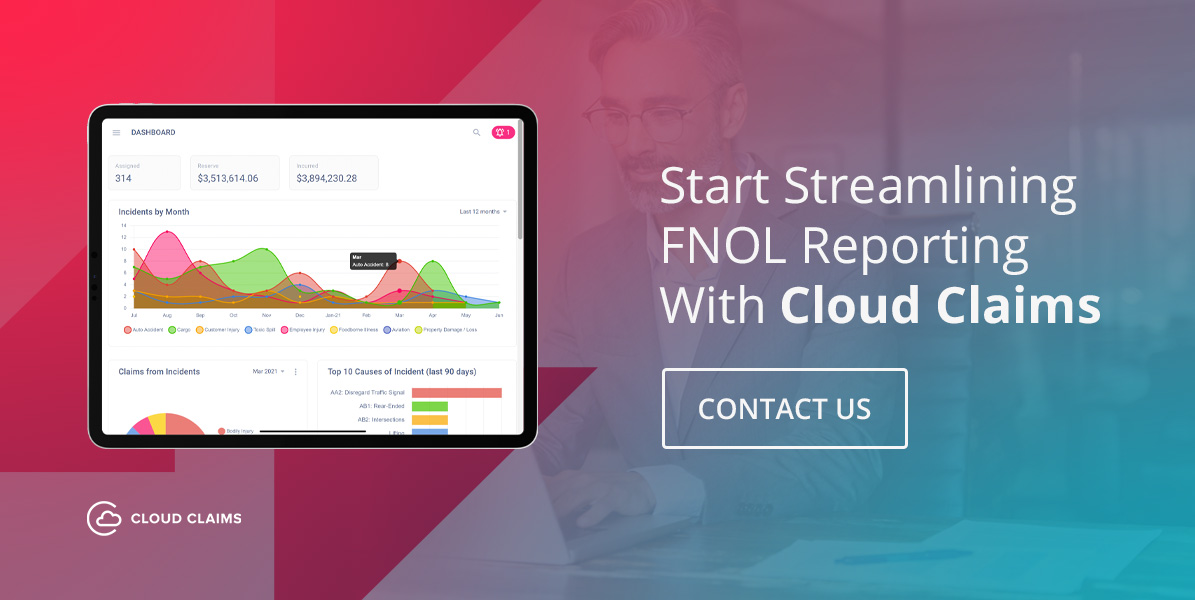The role of employers and claimants in the claims process is important, and it begins with the first notice of loss (FNOL). The FNOL is the first content that initiates the insurance claim process. It is the moment the claimant notifies an employer about any damage, loss or injury, before the employer can respond to an incident. With the necessary information from the FNOL report, adjusters can begin investigating and managing the incident and any related claims.
It is important for self-insured companies to report the FNOL promptly because it can help them follow reporting regulations, address risks before they escalate and start the claim process for claimant satisfaction. However, obstacles to FNOL reporting can delay the process and complicate claims management.
To help you avoid these challenges, here are the top five obstacles to FNOL reporting and what you can do to overcome them.
1. Incidents Are Not Reported in a Timely Manner
If the incident is not reported in a timely manner, it may delay the insurance claim and impact FNOL accuracy. Cumbersome and time-consuming reporting processes are a key reason for underreported workplace injuries. When incidents are not reported immediately, important details like the date, time and circumstances of the event may be forgotten or miscommunicated.
Inaccurate or incomplete information can hinder FNOL submission to the third party administrator (TPA) or insurance carrier. It also prevents risk managers from thoroughly assessing risks. This may keep them from finding the root cause and taking proactive measures to prevent future incidents.
Supervisors, too, may be unclear on their responsibilities. For example, if an employee waits several days to report a slip-and-fall accident, by the time they do, the exact location and conditions may no longer be clear. The wet floor may now be dry, or faulty equipment may have already been fixed during that time.
The use of paper-based reporting can slow down the routing process further. If an employee fills out a paper incident report, it may sit on a supervisor’s desk for days before being forwarded to the appropriate department. In contrast, electronic reporting allows employees to report incidents directly from the field.
2. The Organization Lacks a Standard Incident Reporting Process
A lack of reporting knowledge is a common reason for underreporting work-related injuries. Without a standard operating procedure (SOP) for incident or FNOL reporting, employees may not know what to do. For instance, staff must know how much time they have to report an incident, who to notify and what details to include in their insurance claim. Otherwise, it may lead to late reporting.
Supervisors, too, may be unclear on their responsibilities. For example, a supervisor may be unsure whether they need to conduct a full investigation or simply fill out a basic report after an incident. The lack of clarity can have repercussions. It can result in incomplete documentation and missed opportunities to address safety issues.
This could lead to noncompliance with the Occupational Safety and Health Administration (OSHA). OSHA has recording and reporting regulations companies must follow. Standardizing the process helps avoid noncompliance issues, such as fines or penalties.
3. Reports Are Incomplete or Arrive Piecemeal by Various Methods
Disorganized or scattered incident reporting can lead to common claims management challenges. Such challenges could include miscommunication, errors, incomplete information and delays. For instance, if a video of the incident is emailed separately and a hand-written form is scanned and sent through another method. This scenario creates multiple points of contact. That can be confusing and lead to missing details.
This piecemeal approach contrasts with completing the process online in a single platform. Using an online reporting platform ensures information is captured and submitted together. This streamlined approach can help improve the claim’s accuracy, accessibility and compliance.
4. Key People or Teams Are Not Engaged Quickly Enough
Communication and engagement with stakeholders are important during the claims process. The lack thereof may lead to delays in notifying the right people. Such inefficiencies may result in missed deadlines or potential complications.
For instance, if an FNOL is sent via interoffice mail instead of an automated system, it may take days for the relevant team to receive and act on it. This delay may prevent supervisors from capturing the data or conducting an investigation. What if an organization uses technology but does not have automated alerts set up? Supervisors may not receive immediate notification of an incident.
As a result, key details might be overlooked, and the claim may not be resolved effectively. Quick engagement is essential for accurate reporting and timely response times.
5. There Is a Lack of Follow-Up on Cases
When an incident is perceived as non-critical or minor, it can lead to delays in FNOL reporting because it is deemed not serious. The delay can result in missed opportunities for early intervention and proper FNOL submission. Also, if an injury is not promptly followed up on, the employee may not seek necessary medical care. This may exacerbate the employee’s injury and complicate the claims process. And as such, it can potentially lead to the employer facing legal consequences.
Also, who holds accountability for the incident? A lack of follow-up means the incident cannot be addressed or prevented in case of repeat incidents. Effective follow-up practices can help with proper claims management, accountability and preventive measures.
The Role of Technology in Claims Processes
Claims management software helps organizations with claim processing by streamlining incident reporting. Designed for self-insured companies, TPAs and insurance providers, APP Tech’s Cloud Claims helps clients tackle FNOL reporting challenges.
Cloud Claims software is equipped with various features, including:
- Incident-based design: Users can easily navigate and manage incidents from start to finish.
- Customizable forms: Organizations can tailor their reporting process to their specific needs.
- Streamlined workflows: These workflows help reduce delays and optimize timely engagement.
- Desktop and mobile optimization: The software facilitates real time reporting from any web-enabled device.
Each of our features helps make the claims management process a smooth experience.
Start Streamlining FNOL Reporting With Cloud Claims
Streamlining your FNOL reporting is an important consideration for any business. With the right tools and processes in place, it can help with efficient claims management and risk mitigation.
Cloud Claims offers organizations the tools to capture and communicate incident data efficiently. We are the only company to offer an incident-based risk management information system (RMIS) with a 100 percent implementation success rate. Our technology continues to make processes more efficient.
Are you ready to improve your incident reporting? Contact APP Tech today and see how Cloud Claims can transform your claims process.









